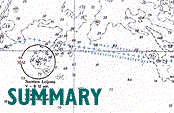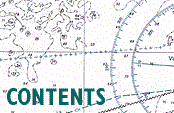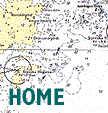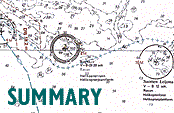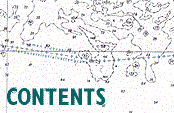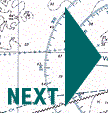 |
The vessel was delivered to Rederiaktiebolaget Sally on 29 June 1980 under the name VIKING SALLY and placed in daily operation between Turku and Mariehamn in Finland, and Stockholm.
 Rederiaktiebolaget Sally, based in Mariehamn, was at that time one of the major Finnish shipping companies with engagement in tankers and passenger vessels. The company was one of three which together formed the marketing consortium “Viking Line” for ferry operations between Finland and Sweden (see 10.2). Rederiaktiebolaget Sally, based in Mariehamn, was at that time one of the major Finnish shipping companies with engagement in tankers and passenger vessels. The company was one of three which together formed the marketing consortium “Viking Line” for ferry operations between Finland and Sweden (see 10.2).
 In 1986, ownership of the vessel was taken over by the Finnish/Swedish group Effjohn, owners of the competing Silja Line. The vessel continued, however, to operate in the Viking fleet under the original name. The technical operation was subcontracted with the remaining part of the Sally company. In 1986, ownership of the vessel was taken over by the Finnish/Swedish group Effjohn, owners of the competing Silja Line. The vessel continued, however, to operate in the Viking fleet under the original name. The technical operation was subcontracted with the remaining part of the Sally company.
 In April 1990 the Effjohn group took over full operation of the vessel and transferred her to the Silja Line under the name SILJA STAR for continued operation between Turku and Stockholm. In April 1990 the Effjohn group took over full operation of the vessel and transferred her to the Silja Line under the name SILJA STAR for continued operation between Turku and Stockholm.
 In January 1991 the vessel was transferred to the Wasa Line, another subsidiary of the Effjohn group, and was placed in the Wasa Line operation in the Gulf of Bothnia between Vaasa in Finland and Umeå and Sundsvall in Sweden. The ship was then renamed WASA KING. She was operated on this route until she was sold to the Estline Marine Company Limited, which is registered in Cyprus. In January 1991 the vessel was transferred to the Wasa Line, another subsidiary of the Effjohn group, and was placed in the Wasa Line operation in the Gulf of Bothnia between Vaasa in Finland and Umeå and Sundsvall in Sweden. The ship was then renamed WASA KING. She was operated on this route until she was sold to the Estline Marine Company Limited, which is registered in Cyprus.
 The ship was under Finnish supervision and flew the Finnish flag from delivery until 14 January 1993. The ship was under Finnish supervision and flew the Finnish flag from delivery until 14 January 1993.
|
 |
 |
The vessel was delivered on 15 January 1993 to the Estline Marine Company Limited. She was registered in Cyprus to satisfy the requirements of the European Bank of Reconstruction and Development for financing the vessel on a mortgage basis. Permission had been obtained for parallel registration in Estonia and the vessel was entered in the Estonian Ship Register on 28 January 1993.
 After delivery drydocking in Turku she entered service for passenger and cargo traffic between Tallinn and Stockholm under the new name, ESTONIA. The first voyage took place on 1 February 1993 and the traffic continued thereafter with departures every second day from Tallinn and Stockholm respectively. Figure 2.1 shows a summary of the vessel's operating history. After delivery drydocking in Turku she entered service for passenger and cargo traffic between Tallinn and Stockholm under the new name, ESTONIA. The first voyage took place on 1 February 1993 and the traffic continued thereafter with departures every second day from Tallinn and Stockholm respectively. Figure 2.1 shows a summary of the vessel's operating history.
Figure 2.1 Ownership and service.

The Estline Marine Company Limited was owned equally by the Estonian Shipping Company Limited (ESCO) and Nordthulin Luxembourg S.A., the latter a company fully owned by the Swedish shipping company Nordström & Thulin AB.
 The vessel was bareboat chartered to the Estonian company E-line Limited, also owned equally by ESCO and Nordthulin Luxembourg S.A. The vessel was bareboat chartered to the Estonian company E-line Limited, also owned equally by ESCO and Nordthulin Luxembourg S.A.
 E-line had signed a Ship Management Agreement with ESCO because ESCO had more extensive resources and experience than E-line for managing operations. E-line had signed a Ship Management Agreement with ESCO because ESCO had more extensive resources and experience than E-line for managing operations.
 ESCO in turn signed a Technical Management Agreement with Nordström & Thulin AB, the reason being that the latter company had more experience of this type of ferry and easier access to spare parts and service. For the same reason Nordström & Thulin was contracted to handle insurance matters regarding the ESTONIA. ESCO in turn signed a Technical Management Agreement with Nordström & Thulin AB, the reason being that the latter company had more experience of this type of ferry and easier access to spare parts and service. For the same reason Nordström & Thulin was contracted to handle insurance matters regarding the ESTONIA.
 The commercial side of the operations, including catering, was handled by the Swedish company Estline AB under an agency agreement with E-line. Estline AB was owned equally by ESCO and Nordström & Thulin. Estline AB had a subsidiary company in Estonia to provide the commercial and catering services in Tallinn. Table 2.1 summarises the ownership of the companies involved in the ESTONIA's operation. Figure 2.2 shows the organisation of the Estline Marine Company Limited. The commercial side of the operations, including catering, was handled by the Swedish company Estline AB under an agency agreement with E-line. Estline AB was owned equally by ESCO and Nordström & Thulin. Estline AB had a subsidiary company in Estonia to provide the commercial and catering services in Tallinn. Table 2.1 summarises the ownership of the companies involved in the ESTONIA's operation. Figure 2.2 shows the organisation of the Estline Marine Company Limited.
Table 2.1 Ownership of companies for operating the ESTONIA.
| Company | Nationality | Owner |
| Estline Marine Co. Ltd | Cyprus | 50 % Estonian Shipping Co. Ltd
50 % Nordthulin Luxembourg S.A. |
| E-Line Ltd | Estonia | 50 % Estonian Shipping Co. Ltd
50 % Nordthulin Luxembourg S.A. |
| Estline AB | Sweden | 50 % Estonian Shipping Co. Ltd
50 % Nordstöm & Thulin AB |
| Estonian Ferry Services Ltd | Estonia | 100 % Estline AB |
| Estonian Shipping Co. Ltd | Estonia | 100 % Estonian State |
| Nordstöm & Thulin AB | Sweden | Public Swedish joint-stock company |
| Nordthulin Luxembourg S.A. | Luxembourg | 100 % Nordstöm & Thulin AB |
Figure 2.2 Organisation of Estline Marine Company Limited.
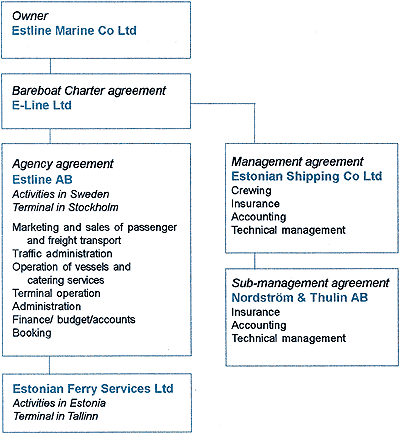
Nordström & Thulin AB is a Stockholm-based public company, established in 1850, with experience of extensive world-wide operation of large modern tankers and bulk carriers, and passenger ferry operations between the Swedish mainland and the island of Gotland in the Baltic Sea. Shipbroking is another important company activity.
 The day-to-day technical management functions regarding the ESTONIA were handled by one full-time superintendent and one purchasing manager, both based in Stockholm. The day-to-day technical management functions regarding the ESTONIA were handled by one full-time superintendent and one purchasing manager, both based in Stockholm.
 ESCO is a Tallinn-based, state-owned stock company. Its history dates back to 1879, when the first shipping company, “Linda”, was established in Estonia. ESCO operates world-wide a variety of cargo vessels of up to 50,000 dwt. ESCO also operates passenger ferries in the Baltic Sea and the Gulf of Finland. In the autumn of 1994 the company owned and operated 55 vessels. ESCO is a Tallinn-based, state-owned stock company. Its history dates back to 1879, when the first shipping company, “Linda”, was established in Estonia. ESCO operates world-wide a variety of cargo vessels of up to 50,000 dwt. ESCO also operates passenger ferries in the Baltic Sea and the Gulf of Finland. In the autumn of 1994 the company owned and operated 55 vessels.
 Operation of the ESTONIA was under the supervision of the Navigational Department of ESCO. The crew was provided by the Personnel Department of ESCO. Two full crews were employed, manning the ship in two-week shifts each. The qualifications and training of the crew are described in Chapter 4. Operation of the ESTONIA was under the supervision of the Navigational Department of ESCO. The crew was provided by the Personnel Department of ESCO. Two full crews were employed, manning the ship in two-week shifts each. The qualifications and training of the crew are described in Chapter 4.
 The master taking over a shift was required to visit the ESCO Navigational, Technical and Personnel departments for briefing. The master being relieved likewise had to report personally to the navigational department of ESCO on the situation on board. The master taking over a shift was required to visit the ESCO Navigational, Technical and Personnel departments for briefing. The master being relieved likewise had to report personally to the navigational department of ESCO on the situation on board.
 A captains' meeting was held at the ESCO office once a week attended by all masters in Tallinn on that day, including those on vacation. Regular meetings were also held on board the ESTONIA, attended by the masters, chief officers and chief engineers of both shifts and by representatives from ESCO and from Nordström & Thulin AB. A captains' meeting was held at the ESCO office once a week attended by all masters in Tallinn on that day, including those on vacation. Regular meetings were also held on board the ESTONIA, attended by the masters, chief officers and chief engineers of both shifts and by representatives from ESCO and from Nordström & Thulin AB.
|
 |
 |
The main part of the Tallinn-Stockholm route was in open sea, while the open-sea part was considerably shorter on the two previous routes. Table 2.2 summarises the route information for all the three routes.
Table 2.2 Routes operated by the ESTONIA.
| Route | Open sea [NM] | Cross-
ings per day | Time per day [h] | Years on route | Total time on open sea [h] |
| 1 Turku - Stockholm | 20 | 2 | 3 | 10.5 | 11 000 |
| 2 Vaasa - Umeå/Sundsvall | 20/75 | 4/2 | 6/6 | 2.0 | 4 000 |
| 3 Tallinn - Stockholm | 150 | 1 | 9 | 1.7 | 5 500 |
No wave statistics exist specifically for the vessel's three operating areas. Some indication of the differences between sea conditions on the three routes may be obtained by comparing the significant wave heights which are exceeded at a probability of 10 % in the different sea areas (Figure 2.3). The wave heights were estimated by the Finnish Institute of Marine Research (MTL). The Institute also predicted wave statistics for the three routes on the basis of their experience, wind statistics, fetch and wave measurements at Bogskär in the northern Baltic Sea (for position, see Figure 13.1) and at Sandbäck in the southern Gulf of Bothnia.
 Table 2.3 presents wave statistics for each route on the area where the worst wave conditions are encountered. The table also shows statistics measured at Bogskär for significant wave heights exceeding 2, 3 and 4 m. Table 2.3 presents wave statistics for each route on the area where the worst wave conditions are encountered. The table also shows statistics measured at Bogskär for significant wave heights exceeding 2, 3 and 4 m.
Table 2.3 Probability of significant wave height exceeding certain levels.
| Significant height greater than [m] | Route 1 Sea of Åland Prob. Lågskär [%] | Route 2 Gulf of Bothnia Vaasa - Sundsvall Prob. [%] | Route 3 Northern Baltic Bogskär* Prob. [%] | Route 3 Northern Baltic South of Utö Prob. [%] |
| 2 | 5.7 | 12.6 | 20.4 | 24.6 |
| 3 | 0.4 | 3.9 | 6.5 | 11.1 |
| 4 | 0.04 | 1.2 | 1.3 | 4.2 |
*Measured
Figure 2.3 indicates that the probability of encountering high seas on the Vaasa-Umeå route is significantly lower than on the Vaasa-Sundsvall route which was run only occasionally and mainly in the summertime. In addition, a review of the weather data from the Gulf of Bothnia for the period when the vessel was operating there indicates that strong winds generating high waves had not existed at any time during this period.
Figure 2.3 Significant wave heights in metres, with 10 % exceedance probability.
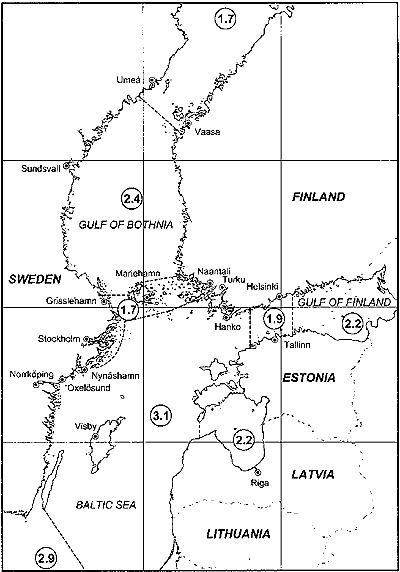
An upper estimate of the time the ESTONIA had spent in rough sea is obtained by combining the time spent in the open sea (Table 2.2) with the probabilities of significant wave height exceeding 3 or 4 m. The times in rough sea are given in Table 2.4 for the operation in the Turku-Stockholm and in the Tallinn - Stockholm traffic. The estimates for the latter traffic assume that the vessel had spent equally long times in the wave climates represented by the Bogskär and by the south-of-Utö wave statistics.
 The vessel may have encountered these high seas from any direction. In the Åland Sea area, heavy seas can only be generated in south-south-easterly or north-westerly directions, thus creating beam seas for vessels sailing on the Stockholm-Mariehamn-Turku route. In the Northern Baltic most of the high sea states are generated in the south to west sector. This means in general port bow or beam seas for a passage from Tallinn to Stockholm and following or beam seas in the opposite direction. The probability of encountering high waves diminishes towards the ends of the open sea part. The vessel may have encountered these high seas from any direction. In the Åland Sea area, heavy seas can only be generated in south-south-easterly or north-westerly directions, thus creating beam seas for vessels sailing on the Stockholm-Mariehamn-Turku route. In the Northern Baltic most of the high sea states are generated in the south to west sector. This means in general port bow or beam seas for a passage from Tallinn to Stockholm and following or beam seas in the opposite direction. The probability of encountering high waves diminishes towards the ends of the open sea part.
Table 2.4 Upper estimates of times the ESTONIA had spent in seas with significant wave height exceeding 3 or 4 m.
| Significant height greater than [m] | Route 1 Turku-Stockholm Time spent in hours | Route 3 Tallinn-Stockholm Time spent in hours |
| 3 | 40 | 500 |
| 4 | 4 | 150 |
|  |


